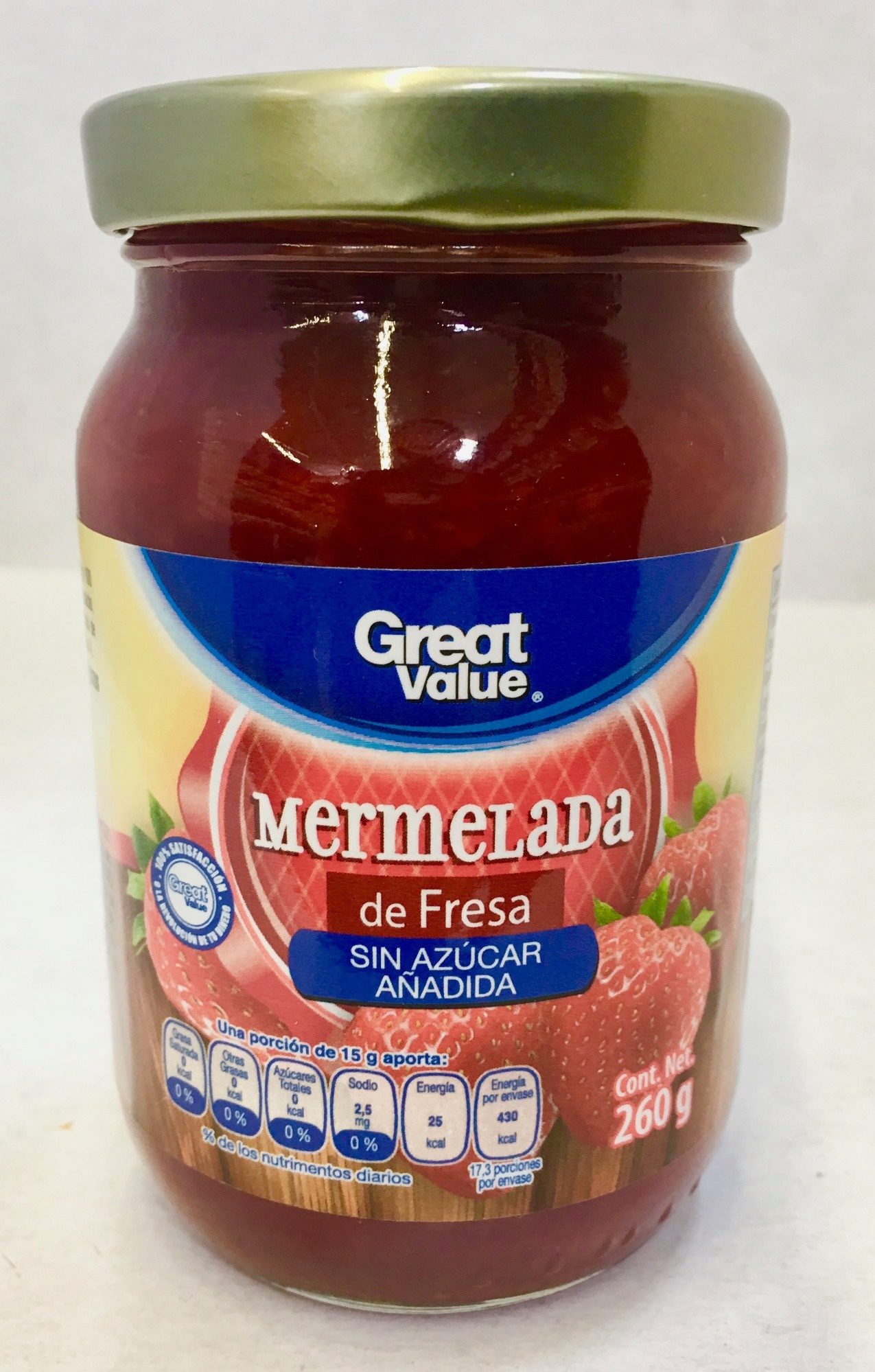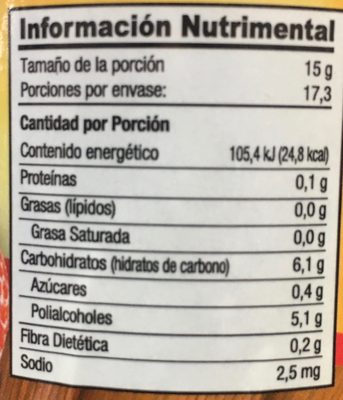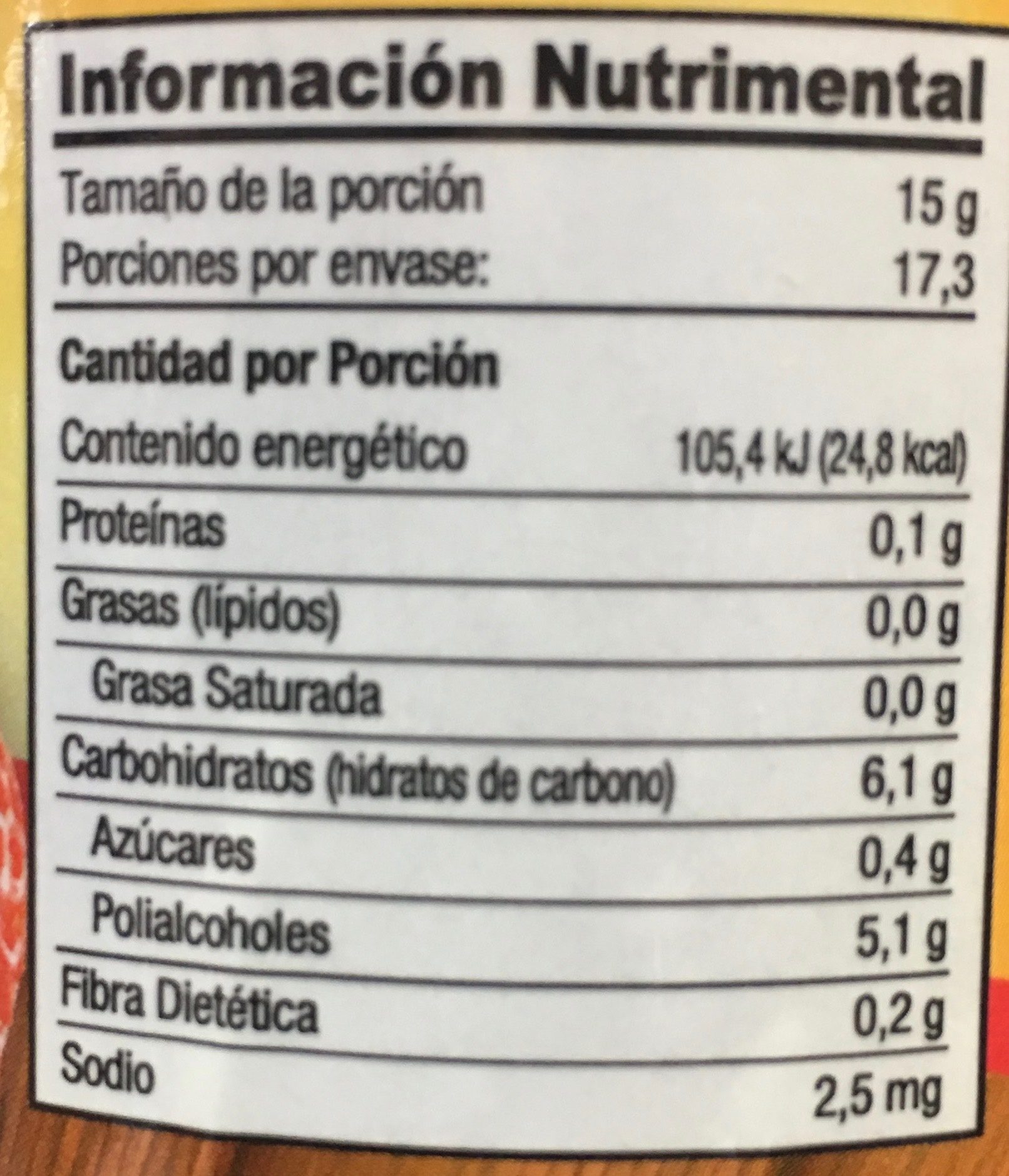Help us make food transparency the norm!
As a non-profit organization, we depend on your donations to continue informing consumers around the world about what they eat.
The food revolution starts with you!
Mermelada de Fresa - Great Value - 260 g
Mermelada de Fresa - Great Value - 260 g
This product page is not complete. You can help to complete it by editing it and adding more data from the photos we have, or by taking more photos using the app for Android or iPhone/iPad. Thank you!
×
Barcode: 7501791647175 (EAN / EAN-13)
Common name: Mermelada de fresas sin azucar añadida
Quantity: 260 g
Packaging: pt:Frasco de cristal con tapa
Brands: Great Value
Categories: Plant-based foods and beverages, Plant-based foods, Breakfasts, Spreads, Plant-based spreads, Sweet spreads, Fruit and vegetable preserves, Jams
Origin of ingredients: Mexico
Manufacturing or processing places: Ciudad de México
Link to the product page on the official site of the producer: http://www.stdalfour.com
Countries where sold: Mexico
Matching with your preferences
Health
Ingredients
-
13 ingredients
: Fresas, isomalt (26,7 g /100 g), sorbitol (10g/100) a pectina, ácido citrico, goma de algarrobo, citrato de calcio benzoato de sodio, colorante anaranjado natural 4, sorbato de potasio, sucralosa (12,5 mg/100 g) y colorante Rojo natural 4.
Food processing
-
Ultra processed foods
Elements that indicate the product is in the 4 - Ultra processed food and drink products group:
- Additive: E410 - Locust bean gum
- Additive: E420 - Sorbitol
- Additive: E953 - Isomalt
- Additive: E955 - Sucralose
Food products are classified into 4 groups according to their degree of processing:
- Unprocessed or minimally processed foods
- Processed culinary ingredients
- Processed foods
- Ultra processed foods
The determination of the group is based on the category of the product and on the ingredients it contains.
Additives
-
E202 - Potassium sorbate
Potassium sorbate (E202) is a synthetic food preservative commonly used to extend the shelf life of various food products.
It works by inhibiting the growth of molds, yeast, and some bacteria, preventing spoilage. When added to foods, it helps maintain their freshness and quality.
Some studies have shown that when combined with nitrites, potassium sorbate have genotoxic activity in vitro. However, potassium sorbate is generally recognized as safe (GRAS) by regulatory authorities.
-
E330 - Citric acid
Citric acid is a natural organic acid found in citrus fruits such as lemons, oranges, and limes.
It is widely used in the food industry as a flavor enhancer, acidulant, and preservative due to its tart and refreshing taste.
Citric acid is safe for consumption when used in moderation and is considered a generally recognized as safe (GRAS) food additive by regulatory agencies worldwide.
-
E410 - Locust bean gum
Locust bean gum: Locust bean gum -LBG, also known as carob gum, carob bean gum, carobin, E410- is a thickening agent and a gelling agent used in food technology.Source: Wikipedia
-
E420 - Sorbitol
Sorbitol: Sorbitol --, less commonly known as glucitol --, is a sugar alcohol with a sweet taste which the human body metabolizes slowly. It can be obtained by reduction of glucose, which changes the aldehyde group to a hydroxyl group. Most sorbitol is made from corn syrup, but it is also found in nature, for example in apples, pears, peaches, and prunes. It is converted to fructose by sorbitol-6-phosphate 2-dehydrogenase. Sorbitol is an isomer of mannitol, another sugar alcohol; the two differ only in the orientation of the hydroxyl group on carbon 2. While similar, the two sugar alcohols have very different sources in nature, melting points, and uses.Source: Wikipedia
-
E953 - Isomalt
Isomalt: Isomalt is a sugar substitute, a type of sugar alcohol used primarily for its sugar-like physical properties. It has little to no impact on blood sugar levels, and does not stimulate the release of insulin. It also does not promote tooth decay, i.e. is tooth-friendly. Its energy value is 2 kcal/g, half that of sugars. However, like most sugar alcohols, it carries a risk of gastric distress, including flatulence and diarrhea, when consumed in large quantities -above about 20-30 g per day-. Isomalt may prove upsetting to the intestinal tract because it is incompletely absorbed in the small intestine, and when polyols pass into the large intestine, they can cause osmotically induced diarrhea and stimulate the gut flora, causing flatulence. As with other dietary fibers, regular consumption of isomalt can lead to desensitisation, decreasing the risk of intestinal upset. Isomalt can be blended with high-intensity sweeteners such as sucralose, giving a mixture that has the same sweetness as sugar. Isomalt is an equimolar mixture of two mutually diastereomeric disaccharides, each composed of two sugars: glucose and mannitol -α-D-glucopyranosido-1‚6-mannitol- and also glucose and sorbitol -α-D-glucopyranosido-1‚6-sorbitol-. Complete hydrolysis of isomalt yields glucose -50%-, sorbitol -25%-, and mannitol -25%-. It is an odorless, white, crystalline substance containing about 5% water of crystallisation. Isomalt has a minimal cooling effect -positive heat of solution-, lower than many other sugar alcohols, in particular, xylitol and erythritol. Isomalt is manufactured in a two-stage process in which sucrose is first transformed into isomaltulose, a reducing disaccharide -6-O-α-D-glucopyranosido-D-fructose-. The isomaltulose is then hydrogenated, using a Raney nickel catalyst. The final product — isomalt — is an equimolar composition of 6-O-α-D-glucopyranosido-D-sorbitol -1‚6-GPS- and 1-O-α-D-glucopyranosido-D-mannitol-dihydrate -1‚1-GPM-dihydrate-. Isomalt has been approved for use in the United States since 1990. It is also permitted for use in Australia, New Zealand, Canada, Mexico, Iran, the European Union, and other countries. Isomalt is widely used for the production of sugar-free candy, especially hard-boiled candy, because it resists crystallisation much better than the standard combinations of sucrose and corn syrup. It is used in sugar sculpture for the same reason.Source: Wikipedia
-
E955 - Sucralose
Sucralose: Sucralose is an artificial sweetener and sugar substitute. The majority of ingested sucralose is not broken down by the body, so it is noncaloric. In the European Union, it is also known under the E number E955. It is produced by chlorination of sucrose. Sucralose is about 320 to 1‚000 times sweeter than sucrose, three times as sweet as both aspartame and acesulfame potassium, and twice as sweet as sodium saccharin. Evidence of benefit is lacking for long-term weight loss with some data supporting weight gain and heart disease risks.It is stable under heat and over a broad range of pH conditions. Therefore, it can be used in baking or in products that require a long shelf life. The commercial success of sucralose-based products stems from its favorable comparison to other low-calorie sweeteners in terms of taste, stability, and safety. Common brand names of sucralose-based sweeteners are Splenda, Zerocal, Sukrana, SucraPlus, Candys, Cukren, and Nevella. Canderel Yellow also contains sucralose, but the original Canderel and Green Canderel do not.Source: Wikipedia
Ingredients analysis
-
Palm oil content unknown
Unrecognized ingredients: es:100, es:a-pectina, es:citrato-de-calcio-benzoato-de-sodio, es:colorante-anaranjado-natural-4, es:12-5-mg, es:colorante-rojo-natural-4Some ingredients could not be recognized.
We need your help!
You can help us recognize more ingredients and better analyze the list of ingredients for this product and others:
- Edit this product page to correct spelling mistakes in the ingredients list, and/or to remove ingredients in other languages and sentences that are not related to the ingredients.
- Add new entries, synonyms or translations to our multilingual lists of ingredients, ingredient processing methods, and labels.
If you would like to help, join the #ingredients channel on our Slack discussion space and/or learn about ingredients analysis on our wiki. Thank you!
-
Vegan status unknown
Unrecognized ingredients: es:100, es:a-pectina, es:citrato-de-calcio-benzoato-de-sodio, es:colorante-anaranjado-natural-4, es:12-5-mg, es:colorante-rojo-natural-4Some ingredients could not be recognized.
We need your help!
You can help us recognize more ingredients and better analyze the list of ingredients for this product and others:
- Edit this product page to correct spelling mistakes in the ingredients list, and/or to remove ingredients in other languages and sentences that are not related to the ingredients.
- Add new entries, synonyms or translations to our multilingual lists of ingredients, ingredient processing methods, and labels.
If you would like to help, join the #ingredients channel on our Slack discussion space and/or learn about ingredients analysis on our wiki. Thank you!
-
Vegetarian status unknown
Unrecognized ingredients: es:100, es:a-pectina, es:citrato-de-calcio-benzoato-de-sodio, es:colorante-anaranjado-natural-4, es:12-5-mg, es:colorante-rojo-natural-4Some ingredients could not be recognized.
We need your help!
You can help us recognize more ingredients and better analyze the list of ingredients for this product and others:
- Edit this product page to correct spelling mistakes in the ingredients list, and/or to remove ingredients in other languages and sentences that are not related to the ingredients.
- Add new entries, synonyms or translations to our multilingual lists of ingredients, ingredient processing methods, and labels.
If you would like to help, join the #ingredients channel on our Slack discussion space and/or learn about ingredients analysis on our wiki. Thank you!
-
Details of the analysis of the ingredients
We need your help!
Some ingredients could not be recognized.
We need your help!
You can help us recognize more ingredients and better analyze the list of ingredients for this product and others:
- Edit this product page to correct spelling mistakes in the ingredients list, and/or to remove ingredients in other languages and sentences that are not related to the ingredients.
- Add new entries, synonyms or translations to our multilingual lists of ingredients, ingredient processing methods, and labels.
If you would like to help, join the #ingredients channel on our Slack discussion space and/or learn about ingredients analysis on our wiki. Thank you!
: Fresas, isomalt, sorbitol (100), a pectina, ácido citrico, goma de algarrobo, citrato de calcio benzoato de sodio, colorante anaranjado natural 4, sorbato de potasio, sucralosa (12‚5 mg), colorante Rojo natural 4- Fresas -> en:strawberry - vegan: yes - vegetarian: yes - ciqual_food_code: 13014 - percent_min: 9.09090909090909 - percent_max: 100
- isomalt -> en:e953 - vegan: yes - vegetarian: yes - percent_min: 0 - percent_max: 50
- sorbitol -> en:e420 - vegan: yes - vegetarian: yes - percent_min: 0 - percent_max: 33.3333333333333
- 100 -> es:100 - percent_min: 0 - percent_max: 33.3333333333333
- a pectina -> es:a-pectina - percent_min: 0 - percent_max: 25
- ácido citrico -> en:e330 - vegan: yes - vegetarian: yes - percent_min: 0 - percent_max: 20
- goma de algarrobo -> en:e410 - vegan: yes - vegetarian: yes - percent_min: 0 - percent_max: 16.6666666666667
- citrato de calcio benzoato de sodio -> es:citrato-de-calcio-benzoato-de-sodio - percent_min: 0 - percent_max: 14.2857142857143
- colorante anaranjado natural 4 -> es:colorante-anaranjado-natural-4 - percent_min: 0 - percent_max: 12.5
- sorbato de potasio -> en:e202 - vegan: yes - vegetarian: yes - percent_min: 0 - percent_max: 11.1111111111111
- sucralosa -> en:e955 - vegan: yes - vegetarian: yes - percent_min: 0 - percent_max: 10
- 12‚5 mg -> es:12-5-mg - percent_min: 0 - percent_max: 10
- colorante Rojo natural 4 -> es:colorante-rojo-natural-4 - percent_min: 0 - percent_max: 9.09090909090909
Nutrition
-
Good nutritional quality
⚠ ️Warning: the amount of fruits, vegetables and nuts is not specified on the label, it was estimated from the list of ingredients: 54This product is not considered a beverage for the calculation of the Nutri-Score.
Positive points: 2
- Proteins: 0 / 5 (value: 0.667, rounded value: 0.67)
- Fiber: 1 / 5 (value: 1.33, rounded value: 1.33)
- Fruits, vegetables, nuts, and colza/walnut/olive oils: 1 / 5 (value: 54.5454545454545, rounded value: 54.5)
Negative points: 2
- Energy: 2 / 10 (value: 703, rounded value: 703)
- Sugars: 0 / 10 (value: 2.67, rounded value: 2.67)
- Saturated fat: 0 / 10 (value: 0, rounded value: 0)
- Sodium: 0 / 10 (value: 16.9, rounded value: 16.9)
The points for proteins are counted because the negative points are less than 11.
Nutritional score: (2 - 2)
Nutri-Score:
-
Nutrient levels
-
Fat in low quantity (0%)
What you need to know- A high consumption of fat, especially saturated fats, can raise cholesterol, which increases the risk of heart diseases.
Recommendation: Limit the consumption of fat and saturated fat- Choose products with lower fat and saturated fat content.
-
Saturated fat in low quantity (0%)
What you need to know- A high consumption of fat, especially saturated fats, can raise cholesterol, which increases the risk of heart diseases.
Recommendation: Limit the consumption of fat and saturated fat- Choose products with lower fat and saturated fat content.
-
Sugars in low quantity (2.67%)
What you need to know- A high consumption of sugar can cause weight gain and tooth decay. It also augments the risk of type 2 diabetes and cardio-vascular diseases.
Recommendation: Limit the consumption of sugar and sugary drinks- Sugary drinks (such as sodas, fruit beverages, and fruit juices and nectars) should be limited as much as possible (no more than 1 glass a day).
- Choose products with lower sugar content and reduce the consumption of products with added sugars.
-
Salt in low quantity (0.0423%)
What you need to know- A high consumption of salt (or sodium) can cause raised blood pressure, which can increase the risk of heart disease and stroke.
- Many people who have high blood pressure do not know it, as there are often no symptoms.
- Most people consume too much salt (on average 9 to 12 grams per day), around twice the recommended maximum level of intake.
Recommendation: Limit the consumption of salt and salted food- Reduce the quantity of salt used when cooking, and don't salt again at the table.
- Limit the consumption of salty snacks and choose products with lower salt content.
-
-
Nutrition facts
Nutrition facts As sold
for 100 g / 100 mlAs sold
per serving (15 g)Compared to: Jams Energy 703 kj
(168 kcal)105.4 kj
(25 kcal)-21% Fat 0 g 0 g -100% Saturated fat 0 g 0 g -100% Carbohydrates 40.7 g 6.1 g -21% Sugars 2.67 g 0.4 g -95% Fiber 1.33 g 0.2 g -7% Proteins 0.667 g 0.1 g +33% Salt 0.042 g 0.006 g +73% Fruits‚ vegetables‚ nuts and rapeseed‚ walnut and olive oils (estimate from ingredients list analysis) 54.545 % 54.545 %
Environment
-
Eco-Score B - Low environmental impact
⚠ ️Select a country in order to include the full impact of transportation.The Eco-Score is an experimental score that summarizes the environmental impacts of food products.→ The Eco-Score was initially developped for France and it is being extended to other European countries. The Eco-Score formula is subject to change as it is regularly improved to make it more precise and better suited to each country.Life cycle analysis
-
Average impact of products of the same category: A (Score: 80/100)
Category: Jam, strawberry
Category: Jam, strawberry
- PEF environmental score: 0.27 (the lower the score, the lower the impact)
- including impact on climate change: 1.42 kg CO2 eq/kg of product
Stage Impact Agriculture
53.9 %Processing
14.3 %Packaging
20.4 %Transportation
8.7 %Distribution
1.8 %Consumption
0.9 %
Bonuses and maluses
-
Origins of ingredients with a high impact
Malus: -3
Environmental policy: -3
Transportation: 0
Origin of the product and/or its ingredients % of ingredients Impact Mexico 100 %High
-
Packaging with a medium impact
Malus: -10
Shape Material Recycling Impact Pouch flask Unknown High ⚠ ️ The information about the packaging of this product is not sufficiently precise (exact shapes and materials of all components of the packaging).⚠ ️ For a more precise calculation of the Eco-Score, you can modify the product page and add them.
If you are the manufacturer of this product, you can send us the information with our free platform for producers.
Eco-Score for this product
-
Impact for this product: B (Score: 67/100)
Product: Mermelada de Fresa - Great Value - 260 g
Life cycle analysis score: 80
Sum of bonuses and maluses: -13
Final score: 67/100
-
Carbon footprint
-
Equal to driving 0.7 km in a petrol car
142 g CO² per 100g of product
The carbon emission figure comes from ADEME's Agribalyse database, for the category: Jam, strawberry (Source: ADEME Agribalyse Database)
Stage Impact Agriculture
23.1 %Processing
17.7 %Packaging
37.0 %Transportation
20.2 %Distribution
1.4 %Consumption
0.5 %
Packaging
-
Packaging with a medium impact
-
Packaging parts
Pouch flask
-
Packaging materials
Material % Packaging weight Packaging weight per 100 g of product
-
Transportation
-
Origins of ingredients
Origins of ingredients with a high impact
Origin of the product and/or its ingredients % of ingredients Impact Mexico 100 %High
Report a problem
-
Incomplete or incorrect information?
Category, labels, ingredients, allergens, nutritional information, photos etc.
If the information does not match the information on the packaging, please complete or correct it. Open Food Facts is a collaborative database, and every contribution is useful for all.
Data sources
Product added on by openfoodfactsmx4
Last edit of product page on by roboto-app.
Product page also edited by packbot.









